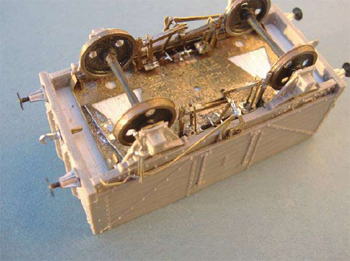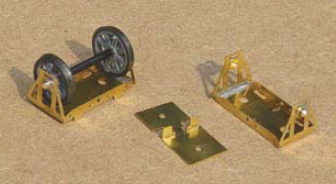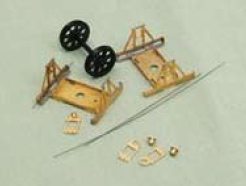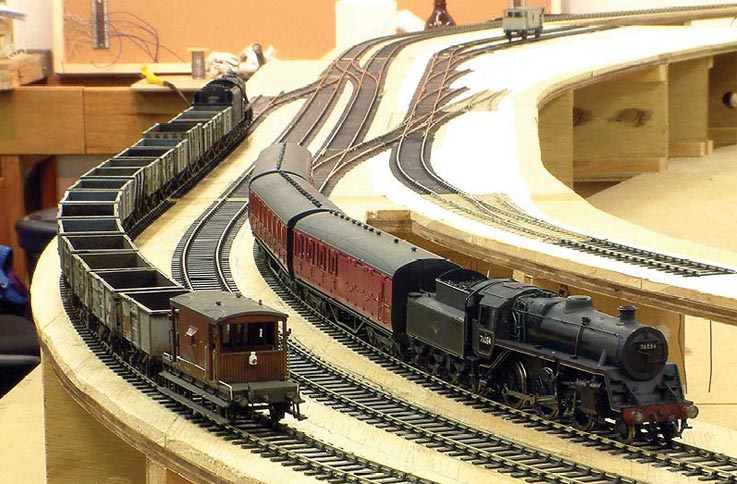Wagons
 "Before
committing themselves wholly to P4, many modellers often create a
trial set-up consisting of a piece of plain track, a turnout and a
couple of four-wheeled wagons. Very wise, so this section will deal
with the basics on Wagons. Of course, you may have qualms about
butchering a couple of your existing wagons, so I am assuming you
begin by building a couple of kits to P4 standards. Then we will look
at converting existing wagons. Before you begin, it is worth pointing
out, especially to established modellers who may have a substantial
amount of rolling stock, that it is not necessary to scrap it all and
start again", says Don Rowland
"Before
committing themselves wholly to P4, many modellers often create a
trial set-up consisting of a piece of plain track, a turnout and a
couple of four-wheeled wagons. Very wise, so this section will deal
with the basics on Wagons. Of course, you may have qualms about
butchering a couple of your existing wagons, so I am assuming you
begin by building a couple of kits to P4 standards. Then we will look
at converting existing wagons. Before you begin, it is worth pointing
out, especially to established modellers who may have a substantial
amount of rolling stock, that it is not necessary to scrap it all and
start again", says Don Rowland
Conversion of wagons
Conversion to P4 is perfectly feasible, indeed I've a number of vehicles on my layout which began life as EM, or even - whisper it - OO models. In theory (a catch-all phrase if ever there was one), all one needs to do is change the wheels for ones to P4 gauge and profile but sadly that assumes perfect trackwork. In practice all those minor dips and humps that OO wheels with their deeper flanges tolerated quite happily are as unhelpful in P4 as they are in the real thing, so we too have to allow for them. We do so either by compensation or springing.
Whilst it may not give quite such good results as springing, compensation is somewhat easier, and is far more widespread amongst the P4 fraternity although springing is gaining in popularity. On a compensated four-wheeled wagon one axle remains fixed whilst the other pivots at the central point allowing it to rock. On encountering a dip in one rail the weight of the wagon pushes one wheel down thus keeping all wheels in contact with the rail and keeping it on the track. Springing usually applies to all axles and is thus more complicated, not helped by the fact that materials behave differently in model form. We will look at springing in more detail later but first let us consider how you build your two P4 wagons.
Pass the craft knife
You will be aware of the numerous wagon kits available nowadays. In their more recent releases both Parkside Dundas and 51L have made minor changes which make life that bit easier for P4 modellers and my only caveat is that, to begin, with you should choose wagons with solid floors; wagons such as tankers with all their framing steelwork showing are definitely not for the beginner. You will also need two sets of suspension units and two sets (four axles worth) of wheels. Bill Bedford, Alan Gibson and the Scalefour Society all sell the units and, along with Kean Maygib, suitable 3' 1½" diameter wheels on pin-point axles and bearings to go with them. Exactoscale sell similar items and they also produce wheels with parallel axle ends and the appropriate bearings.
Your kits will almost certainly have axleguards and boxes cast or moulded integrally with the solebars. Remove these carefully along with any ribs on the underside of the floor; assemble your wheels and suspension units according to the manufacturer's instructions; fix them to the underside of the floor; and you have a basic P4 wagon. Add the axleguards, and from then on it's just the same as it was in, say, OO, except that now you will find the brakes line up with the wheels. Before you do that though there are two checks to be made. First, make sure your rocking axle does actually rock; each wheel should move up and down freely at least half a millimetre. Secondly, give your wagon a gentle push along the workbench. If it goes in a nice straight line, fine, but if it veers off in a gentle arc your axles are not parallel and a bit of remedial action is needed.
Compensation was evolved as the first method of getting good running vehicles in P4 and many suppliers developed their own designs. Some, such as Studiolith, Colin Waite and D&S Models are no longer in production, leaving the field to others like Alan Gibson and the Scalefour Society.
 An example of
the compensated suspension system as applied to wagon stock. The two
units are the ones the Scalefour Society supplies consisting of two
sets of fold-up etches, four pinpoint bearings plus one set of P4
wagon wheels with pin-point axles. With a second set of wheels there
is sufficient for one four-wheeled wagon. The left-most unit, with
bearings and spoked wheels in situ, is fixed to the wagon
floor. Beside it, showing its component parts, is the rocking unit,
pivoted centrally to allow the wheelset to rise and fall slightly to
accommodate track variations.
An example of
the compensated suspension system as applied to wagon stock. The two
units are the ones the Scalefour Society supplies consisting of two
sets of fold-up etches, four pinpoint bearings plus one set of P4
wagon wheels with pin-point axles. With a second set of wheels there
is sufficient for one four-wheeled wagon. The left-most unit, with
bearings and spoked wheels in situ, is fixed to the wagon
floor. Beside it, showing its component parts, is the rocking unit,
pivoted centrally to allow the wheelset to rise and fall slightly to
accommodate track variations.
In fact springing was around before compensation - S&B were producing self-contained sprung axleboxes in 4mm scale over 40 years ago - but it tends to involve a bit more work and the methods vary as between the suppliers, but all aim to keep the wheels on the track, generally by the use of spring steel wire.
Bill Bedford and Exactoscale both sell their own systems, with instructions, as does Michael Clark. This latter supplier really comes into his own with kits to convert ready-to-run wagons. Here, with numerous different manufacturers, each having his own ideas and production methods, there is no standard method of conversion and Michael has produced a range of universal kits.
Inevitably, conversion is not quite so straightforward with some models but with the excellent plastic mouldings now available an accurate, well-detailed P4 wagon can often be produced with relatively little effort.
The photo at the head of this article shows a completed wagon with sprung suspension, this time using a system developed by Michael Clark from his 'Masokits' range of components. The result is so unobtrusive it is difficult to spot even from the underside.
 Springing, where the suspension mimics the full-size wagon, is
a newer development but, having said that, the author has two sprung
wagons which are 14 years old. Illustrated is a pair of sprung units
to Bill Bedford's design plus a wheelset of open spoked wheels. Here
both units are fixed to the wagon but the wheels, with pin-point
axles, run in bearings which are allowed to move up and down in the
suspension units controlled by spring steel wire. The components for
one four-wheeled wagon are shown (less one wheelset) with a bearing,
spring carrier and spring in position on one unit.
Springing, where the suspension mimics the full-size wagon, is
a newer development but, having said that, the author has two sprung
wagons which are 14 years old. Illustrated is a pair of sprung units
to Bill Bedford's design plus a wheelset of open spoked wheels. Here
both units are fixed to the wagon but the wheels, with pin-point
axles, run in bearings which are allowed to move up and down in the
suspension units controlled by spring steel wire. The components for
one four-wheeled wagon are shown (less one wheelset) with a bearing,
spring carrier and spring in position on one unit.
Let me end with several comments:
- First, most British wagons used to be four-wheeled, but bear in mind that the longer the wheelbase the more important it is to have springing or compensation.
- Secondly there are mercifully few six-wheeled wagons; again they are not for beginners but I shall consider them in the next section.
- Modern bogie wagons are like bogie coaches, which I also mention in the next section, though their short bogies with their short wheelbase reduce the need for compensation or springing.
- Finally, if you are going to do any shunting a la prototype, you will find that sprung buffers improve operations as does a bit of extra weight. The Society recommends 25 grams per axle and this is usually achieved by adding lead in suitable places. As a guide, old roofing lead is approximately 2.5mm thick and, in round figures, weighs roughly 2.5 grams per square centimetre. With covered vans and loaded open wagons, finding space is not normally a problem but with, say, a small, open wagon built from a plastic kit, a degree of ingenuity in packing every space between the solebars usually produces the required result.

Slattocks, a major P4
layout, is under construction by members of the Manchester Model
Railway Society.
